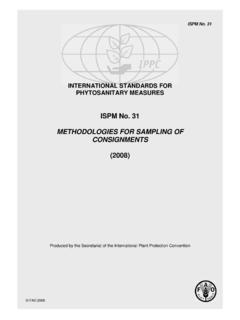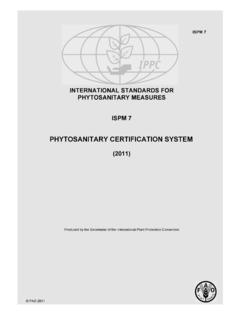Transcription of DRAFT SANITARY AND PHYTOSANITARY STRATEGY …
1 DRAFT SANITARY AND PHYTOSANITARY . STRATEGY . January 2014. DIRECTORATE: FOOD IMPORT AND EXPORT standards . Table of Contents 1. INTRODUCTION ..1. 2. PURPOSE ..2. 3. STRATEGIC OBJECTIVES ..3. 4. SCOPE OF THE STRATEGY ..3. 5. international SPS POLICY CONTEXT: The World Trade Organization's Agreement on the Application of SANITARY and PHYTOSANITARY Measures (WTO SPS Agreement) ..4. 6. CURRENT STATUS OF SPS MANAGEMENT CAPACITY IN. SOUTH AFRICA ..7. SPS REGULATORY FRAMEWORK ..8. INSTITUTIONAL ARRANGEMENTS ..10. IMPLEMENTATION OF THE WTO SPS AGREEMENT ..12. Assessment of SPS risks through science based approaches ..12. Harmonization with international standards ..15. Mutual recognition of equivalence ..16. Adapting to regional conditions, including the establishment of pest or disease free areas and areas of low pest prevalence ..17. Transparency ..18. Dispute settlement ..18. PARTICIPATION IN REGIONAL SPS COORDINATION MECHANISMS.
2 19. RECOGNITION AND COMMUNICATION ON SPS ISSUES ..20. MARKET ACCESS AND RELATED SPS ISSUES ..20. STAKEHOLDER ENGAGEMENT PLATFORMS ..21. 7. KEY ISSUES AND STRATEGIC INTERVENTIONS ..22. Advancing SPS legislative reform, coordination and clarification of organisational mandates and responsibilities ..23. Improving SPS institutional capacity to ensure consistency and compliance with international commitments ..24. Exploiting opportunities for SPS Technical Assistance ..25. Enhancing market access through SPS compliance ..27. Opportunities for SPS stakeholder partnerships ..28. i Effective SPS Communication and Awareness ..29. Promoting Regional SPS Cooperation ..30. 8. IMPLEMENTATION FRAMEWORK ..31. ANNEXURE A: REFERENCES ..32. ANNEXURE B: List Of ii 1. INTRODUCTION. Globalization coupled with increased trade in agricultural commodities presents both opportunities and risks. On the one hand, exports of agricultural commodities generates much needed foreign revenue and on the other, it presents new pathways for the introduction and spread of pests and diseases that can have a profound effect on agricultural production with potentially dire economic consequences.
3 Exploitation of global market opportunities for agricultural and food products is subject to compliance with international standards , such as SANITARY and PHYTOSANITARY (SPS) measures that aims to provide the required protection against risks that may threaten human, animal and plant health and life. SPS measures are mandatory requirements adopted by countries to protect the health and lives of humans, animals and plants from risks associated with diseases, pests and contamination of foodstuffs, and to prevent damage caused by the establishment or spread of pests and diseases. The application of SPS measures within the global trade environment is governed by the World Trade Organisation's Agreement on SANITARY and PHYTOSANITARY Measures (WTO SPS Agreement). Whilst the WTO SPS Agreement affords member countries the right to apply SPS measures to provide for an appropriate level of protection (ALOP) for the life and health of humans, animals and plants, it also determines that such measures should be scientifically justified, non discriminatory and should not create unfair barriers to trade.
4 The significance of South Africa's (SA) participation in the global economy is reflected in the increasing economic value associated with exports of agricultural commodities such as fruits, animal, and fishery products. However, with market access of our agricultural commodities being increasingly under threat due to evolving SPS requirements, sustained economic growth from these exports will be dependent on how efficiently the South African SPS management system is able to respond to and ensure compliance in meeting its SPS. obligations and responsibilities in the interest of promoting fair and safe trade. SPS issues continue to also have an impact at a national level. This is evident from the increasing costs incurred by government and producers for mitigation of pest introductions and recurring disease outbreaks such as Foot and Mouth disease (FMD) that result in substantial loss of 1. earnings each year and negatively impacts rural communities that depend on agricultural production for their livelihood.
5 For example the 2010 outbreak of FMD has been estimated to have cost the country R4 billion in export losses. While SA is self-sufficient in some key agricultural commodities and food products, it still relies on global imports to address shortages in the food supply. The need to import brings along with it SPS risks from exporting countries. Furthermore as an internationally recognised tourism destination, international travellers to SA constitute an additional pathway for the entry of exotic organisms into the country. Therefore SPS risks presented through imports and tourism requires strengthened management of potential SPS risks, particularly at the ports of entry. There is currently no overarching framework that provides for management of SPS issues in a holistic, comprehensive and coordinated manner. This STRATEGY therefore aims to provide an integrated approach to mobilise SA's SPS management capacity in support of complying with its international SPS commitments under the WTO and to meet SPS market requirements for agricultural and food commodities in support of national and international trade and development objectives.
6 Considering the multidisciplinary nature of SPS issues and the range of institutional responsibilities carried out by various role-players, this STRATEGY document will firstly, focus on the status of SA's SPS management capacity specifically highlighting some of the challenges impacting its ability to meet its international obligations and secondly, identify key areas within the SPS system that needs to be addressed and propose interventions that would facilitate an efficient, proactive and integrated response to emerging SPS risks going forward. 2. STRATEGIC GOAL OF THE SPS STRATEGY . The goal of the SPS STRATEGY is to provide for an overarching national framework that aims to enhance and strengthen the ability of SA to satisfy its obligations in terms of the WTO. SPS Agreement, to provide adequate protection against risks threatening human, animal, plant life and health and to enhance SA's competitiveness to fully benefit from market access opportunities.
7 2. 3. OBJECTIVES. To achieve a robust and responsive SPS management system as envisioned by the STRATEGY the focus areas for implementation will be to: Promote SPS legislative reform that is harmonised with international requirements and facilitates animal health, plant health, and food safety through the application of science based SPS measures that are applied to all levels of policy, planning, and decision making;. Enhance integration between and amongst relevant SPS implementing agencies at National, Provincial, and Local government with clear roles and responsibilities;. Strengthen and integrate SPS management capacity to facilitate improved compliance in terms of SPS obligations of relevant international agreements and bodies;. Promote stakeholder engagement and support along the value chain by building and establishing partnerships that recognise SPS as a shared responsibility;. Improve the level of SPS communication and awareness within government as well as amongst relevant stakeholder groups.
8 Exploit opportunities to strengthen SPS capacity and skills that will have maximum impact on SPS compliance for safe and responsible domestic and international trade of agricultural and food products; and Enhance SPS diplomacy through active participation in bilateral, multilateral and negotiating fora and SPS coordination mechanisms. 4. SCOPE OF THE STRATEGY . Considering the extensive scope of SPS matters, the focus of the STRATEGY will be to reconcile SPS management capacity with appropriate implementation strategies to build and develop the efficiency with which the SPS management system is able to appropriately respond to all significant SPS risks threatening agriculture, forestry, horticulture, fisheries, native biodiversity, and human health. For purposes of this STRATEGY all terminology related to SPS matters are as defined within the scope of the WTO SPS Agreement and recognised international standard setting bodies for plant health, food safety and animal 3.
9 Health. The STRATEGY excludes issues relating to the protection of private market requirements ( private standards ), animal welfare and the framework for managing genetically modified organisms (GMO), except where scientific evidence determines that GMO's approved in SA should be classified as an SPS risk. 5. international SPS POLICY CONTEXT: The World Trade Organisation's Agreement on the Application of SANITARY and PHYTOSANITARY Measures (WTO. SPS Agreement). The WTO SPS Agreement establishes international rules for the application of SPS. measures in international trade of food and agricultural products. The Agreement explicitly recognizes the right of countries to apply SPS measures to provide an ALOP for the life and health of humans, animals and plants, provided that such measures can be justified scientifically, are non discriminatory and do not create unfair barriers to trade. SPS. measures are defined within the WTO SPS Agreement as any measure applied: to protect animal or plant life or health from risks arising from the entry, establishment or spread of pests, diseases, disease-carrying organisms or disease-causing organisms.
10 To protect human or animal life or health from risks arising from additives, contaminants, toxins or disease-causing organism in foods, beverages or feedstuffs;. to protect human life or health from risks arising from diseases carried by animals, plants or products thereof, or from entry, establishment or spread of pests; or to prevent or limit other damage from the entry, establishment or spread of pests. The WTO SPS Agreement is underpinned by several key elements to ensure that its objectives are achieved. These are briefly described as follows: Harmonization The WTO SPS Agreement calls for countries to base their SPS measures on international standards , guidelines, and recommendations developed by international standard setting organizations. The objective in promoting the use of international standards is to facilitate trade by harmonizing SPS measures of different countries on as wide a basis as possible. 4. Countries are permitted to adopt measures that achieve a higher level of protection, provided that it can be scientifically justified.









